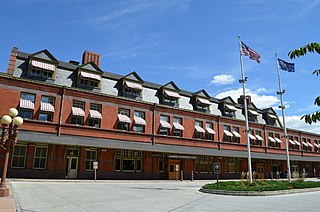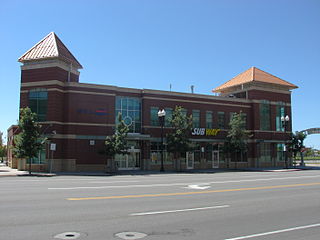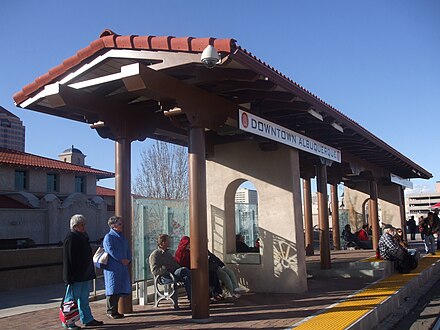
ABQ RIDE is the local transit agency serving Albuquerque, New Mexico. ABQ RIDE operates a variety of city bus routes including two Albuquerque Rapid Transit (ART) bus rapid transit lines and a currently suspended ARTx express bus line It is the largest public transportation system in the state, serving 6,907,500 passengers in 2023, or about 21,100 per weekday as of the fourth quarter of 2023.

Rapid Ride was an express bus service with limited bus rapid transit (BRT) features which was operated by ABQ RIDE, the local transit agency in Albuquerque, New Mexico, from 2004 to 2020. The Rapid Ride name was phased out in 2020 with the rebranding of the one remaining Rapid Ride line as ARTx, though the service remains essentially the same.

The New Mexico Rail Runner Express is a commuter rail system serving the metropolitan areas of Albuquerque and Santa Fe, New Mexico. It is administered by the New Mexico Department of Transportation (NMDOT) and the Rio Metro Regional Transit District, a regional transportation agency, while Herzog Transit Services currently holds the contract for the operation and maintenance of the line & equipment. Phase I of the system, operating on an existing right-of-way from Belen to Bernalillo that NMDOT purchased from BNSF Railway, opened in July 2006. Phase II, the extension of the line to Santa Fe, opened in December 2008. Daily ridership, as of February 2019, was 2,200 trips per day. In 2023, the system had a ridership of 584,400, or about 1,900 per weekday as of the fourth quarter of 2023.

Everett Station is an Amtrak train station serving the city of Everett, Washington, United States. The station has provided service to the Cascades and Empire Builder routes since its opening in 2002, replacing an earlier station near the Port of Everett. The four-story building also houses social service programs and is the center of a 10-acre (4 ha) complex that includes parking lots and a large bus station used primarily by Community Transit, Everett Transit, and Sound Transit Express. The station has served as the northern terminus of the Sounder N Line since 2003 and the Swift Blue Line since 2009. It consists of two side platforms, one serving Amtrak and the other serving Sounder commuter trains. Everett Station also functions as a park and ride, with 1,067 short-term parking spaces located in lots around the station after it was expanded by Sound Transit in 2009.

The Harrisburg Transportation Center is a railway station and transportation hub in Harrisburg, Pennsylvania. It is located on the eastern edge of Downtown Harrisburg between the intersections of Aberdeen and Market Streets and 4th and Chestnut Streets.

Downtown Albuquerque is the central business district of Albuquerque, New Mexico, United States. It is where a significant number of the city's highrise buildings are located, and is the center of government and business for the Greater Albuquerque metropolitan region.
This is a documentation of the routes, highways, parking requirements, or anything related to transportation in Houston.

Hartford Union Station is a railroad station in Hartford, Connecticut, United States on the New Haven–Springfield Line. It is served by Amtrak Hartford Line, Northeast Regional, Valley Flyer, and Vermonter intercity rail service, plus CT Rail Hartford Line commuter rail service and CTfastrak bus rapid transit service.

Detroit station is an intermodal transit station in Detroit, Michigan. Located in New Center, the facility currently serves Amtrak and QLine streetcars. It also serves as a stop for Greyhound Lines, Detroit Department of Transportation buses, SMART and buses. Baltimore Street station, in the median of Woodward Avenue, serves streetcars to Midtown and Downtown. It is located at the southwest corner of Woodward and West Baltimore Avenues. Amtrak's Wolverine line serves an elevated platform at the main building.
Central Avenue is a major east–west street in Albuquerque, New Mexico, which historically served as the city's main thoroughfare and principal axis of development. It runs through many of Albuquerque's oldest neighborhoods, including Downtown, Old Town, Nob Hill, and the University of New Mexico area. Central Avenue was part of U.S. Route 66 from 1937 until the highway's decommissioning in 1985 and also forms one axis of Albuquerque's house numbering system. It was also signed as Business Loop 40 until the early 1990s when ownership of Central Avenue was transferred from the New Mexico State Highway Department to the City of Albuquerque.

The Salt Lake City Intermodal Hub is a multi-modal transportation hub in Salt Lake City, Utah, United States served by the Blue Line of UTA's TRAX light rail system that operates in Salt Lake County and by the FrontRunner, UTA's commuter rail train that operates along the Wasatch Front with service from Ogden in central Weber County through Davis County, Salt Lake City, and Salt Lake County to Provo in central Utah County. Service at the intermodal hub is also provided by Amtrak, and Greyhound Lines, as well as UTA local bus service.

CTfastrak is a regional bus rapid transit system currently operating between downtown Hartford and Downtown New Britain station in New Britain in central Connecticut. Operated by Connecticut Transit, it is the first bus rapid transit system in Connecticut and the second in New England after the MBTA Silver Line. CTfastrak opened on March 28, 2015 after fifteen years of planning and three years of construction.

The Santa Rosa Transit Mall is a major transfer point for several bus routes serving the city of Santa Rosa, California, located in Sonoma County, north of San Francisco, in the United States. From the Transit Mall, passengers can travel throughout Santa Rosa and Sonoma County, plus destinations that connect the city with the rest of the San Francisco Bay Area and the Redwood Empire.

The Tracy Transit Center is a bus station in Tracy, California, United States. The facility serves as a bus hub for transportation on local, commuter, and long-distance bus services. It also replaced the Naglee Park and Ride Lot "as the place for people to meet buses and vanpools" when the Naglee lot was sold for development in spring 2017, "after the city’s negotiations with several shopping centers near Interstate 205 proved unsuccessful."

Ogden Central Station is a commuter rail train and bus station in Ogden, Utah, United States. It is served by the FrontRunner, Utah Transit Authority's (UTA) commuter rail train, the Ogden Express, a UTA bus rapid transit service, as well as UTA local and commuter bus service, and Greyhound Lines long-distance bus service.

Provo Central station is an intermodal transit station in Provo, Utah, United States. It is served by the Utah Transit Authority's (UTA) FrontRunner commuter rail line as well as local, intra-county, and interstate buses. It is the southern terminus of the commuter rail system, with service running north as far as Ogden. The station is also known as Provo Intermodal Hub, Provo Station, or Provo CRS. It is part of the FrontRunner South extension.

Montaño is a station on the New Mexico Rail Runner Express commuter rail line on Montaño Rd. between Edith Blvd. and Second St., in Albuquerque, New Mexico. The station opened on April 7, 2014, marking the end of construction of the Montaño Transit Center.

Albuquerque Rapid Transit, also known as ART, is a bus rapid transit (BRT) system serving the Central Avenue corridor in Albuquerque, New Mexico, United States. There are two lines running between Tramway Boulevard, the Central and Unser Transit Center (CUTC), and the Uptown Transit Center (UTC). It was built in 2016–17 and began limited operation in November 2017, but was subsequently delayed for over two years due to problems with the stations and buses. After the original fleet of electric buses was replaced with diesel buses, the line began regular service on November 30, 2019.
























